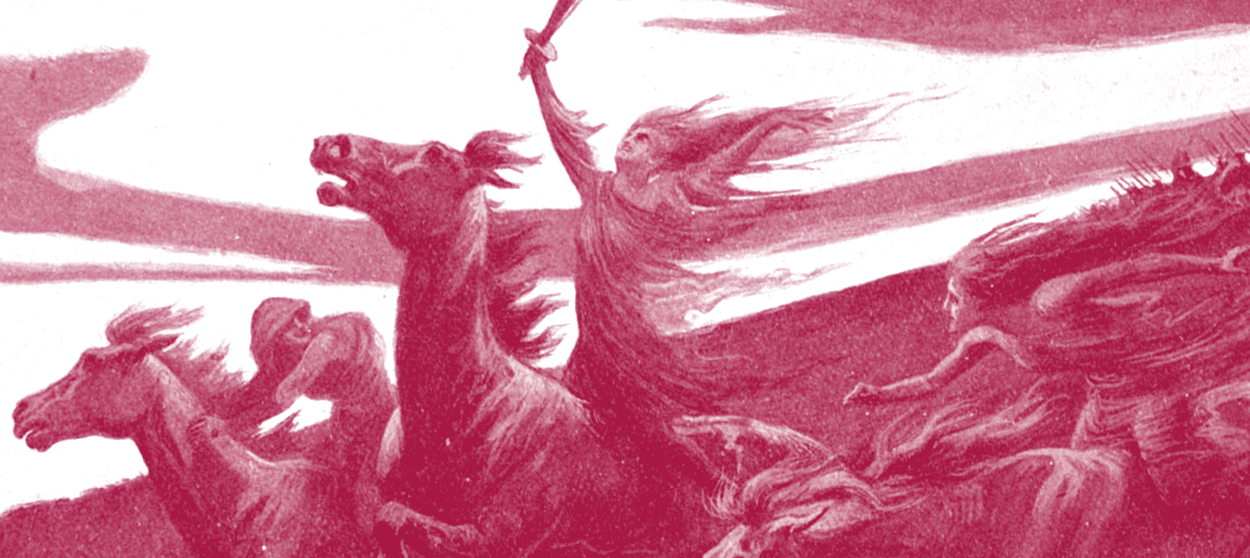The myth of the Viking woman warrior
Women don't have to wield weapons to be strong

In 2017, a team of Swedish archaeologists announced an exciting discovery: They had, for the first time, identified the remains of a Viking woman warrior. A DNA analysis of a Viking Age skeleton previously thought to be male had turned out to be female. The skeleton in question was originally discovered in 1878 in a grave known as Bj. 581 at the Swedish Viking Age trading town of Birka. Lacking the scientific knowledge available today to determine the biological sex of human remains, the 19th-century archaeologists looked at the objects buried with the skeleton — weapons like swords and spears, shields, and even the remains of several horses — and declared the human remains to have belonged to a male warrior. The modern DNA result proved this theory wrong.
The tale of the Viking woman warrior from Birka continues to capture our imaginations. She has even been called a "real-life Viking version" of Game of Thrones' iconic female knight, Brienne of Tarth. But what hasn't attracted as much attention is the ongoing controversy among scholars about the validity of these recent conclusions. According to the critics, the claim that the woman in Bj. 581 had been a warrior is based on some wobbly assumptions. That we so desperately want to believe in the Viking woman warrior, despite evidence to the contrary, says a lot about the ongoing women's movement, and betrays our rigid ideals of how we want female strength to be displayed.
During the Viking Age (c. 800–1050), men and women from what is today Norway, Sweden, and Denmark set sail to new lands and spread out across a vast area reaching from the North Atlantic to the Caspian Sea and the Mediterranean. In popular culture, Vikings are mainly known for their fighting abilities, but being a warrior was only a part-time occupation in a life otherwise based on farming and fishing, in which both men and women were needed for the family to survive. At the same time, Viking Age Scandinavia was a violent society, fueled by vendettas and power struggles. People needed to know how to fight and how to defend themselves.
The Week
Escape your echo chamber. Get the facts behind the news, plus analysis from multiple perspectives.

Sign up for The Week's Free Newsletters
From our morning news briefing to a weekly Good News Newsletter, get the best of The Week delivered directly to your inbox.
From our morning news briefing to a weekly Good News Newsletter, get the best of The Week delivered directly to your inbox.
Out of this violence grew a warrior ideal that came to permeate Viking Age Scandinavian society. According to Norse mythology, a warrior killed in battle earned a place in Valhalla. As far as we know, this warrior ideal was associated with masculinity, and Valhalla was a place reserved for men. However, Norse mythology also contains women who were associated with battle, namely the Valkyries.
When we think of the Valkyries, we tend to conjure images of buxom women with braids and horned helmets. But the Vikings would not have recognized this interpretation; the Valkyries were mythological creatures, not actual women who walked the Earth. And they were not associated with femininity, but with carnage. As archaeologist Neil Price points out, the Valkyries of the Viking Age were thought to be more like battle demons than female superheroes. They were vicious creatures, serving a vicious god.
In addition to the Valkyries, the Icelandic sagas mention shield maidens, women who wielded weapons and fought in battle. But similarly to the Valkyries, there is no evidence they ever really existed.
In other words, there is very little in the history books to support the claim that the skeleton in Bj. 581 was a Viking woman warrior. In fact, we can't say for certain that this individual was a woman, a warrior, or even a Viking.
A free daily email with the biggest news stories of the day – and the best features from TheWeek.com
While the DNA evidence suggests this skeleton belonged to a female, we don't know enough about how gender and biological sex related to one another during the Viking Age to conclusively say how this person identified. On the one hand, there seems to have been a clear delineation between men and women: On the family farm, chores were gender-coded as either male or female; from the sagas, we learn that cross-dressing was grounds for divorce. On the other hand, it wasn't uncommon for female skeletons to be buried with male-coded objects, such as weapons. We still don't know what this meant to the Vikings, but it does mean that Bj. 581 is not unique.
That the individual buried in Bj. 581 was a warrior is also hard to confirm, because as professor of Viking studies Judith Jesch observed, the skeleton shows no marks or wear that might be associated with battle woulds.
Finally, the grave objects in Bj. 581 are not Scandinavian, which raises the question of whether this person was a Viking at all. Instead, the weapons, the clothes, and the animals found in this grave seem to have originated nearer the Caspian Sea, which is located in Central Asia.
So why does the myth of the Viking woman warrior endure? The answer has to do, in part, with our shifting ideas about what female rage, strength, and empowerment look like. Claiming the Viking woman warrior existed allows her to be co-opted as a sort of mascot for the ongoing women's movement. She serves as a canvas onto which we project fantasies of vengeance and power without upsetting the status quo. "Maybe it's empowering to some extent," Charlotte Hedenstierna-Jonson, the lead author of the paper concluding the skeleton was a woman warrior, told The New York Times. "There is always hope that there were female warriors."
Until more solid evidence comes to light, the Viking woman warrior remains a fantasy. And unfortunately, apart from sensational discoveries like that of the individual who was laid to rest in Bj. 581, Viking Age women are rarely spoken of at all. It is not until they behave like Viking Age men, wielding swords and running into battle, that they are considered worthy of our attention. We dismiss all the other ways in which Viking women were strong and empowered, and at the same time undermine all the ways in which modern women can be strong and empowered without ever picking up a weapon.
Viking women were strong, even if they weren't warriors. Eking out a living on a farm in or near the Arctic 1,000 years ago took a certain type of robust character. In the harsh climate, growing crops and reaping a harvest was backbreaking work with little reward. There was no modern medicine with which to ease the pains of illness, injury, old age, and of course, childbirth.
But perhaps most importantly, the Viking women's craft and artistry were pivotal to their people's regional proliferation. The women wove the sails that brought the iconic Viking ships to new shores, where these adventurous Scandinavians could raid, trade, and settle. Indeed, without the work of women, the Viking Age would never have happened.
Want more essential commentary and analysis like this delivered straight to your inbox? Sign up for The Week's "Today's best articles" newsletter here.
-
 Why is Trump’s alleged strike on Venezuela shrouded in so much secrecy?
Why is Trump’s alleged strike on Venezuela shrouded in so much secrecy?TODAY'S BIG QUESTION Trump’s comments have raised more questions than answers about what his administration is doing in the Southern Hemisphere
-
 Vance’s ‘next move will reveal whether the conservative movement can move past Trump’
Vance’s ‘next move will reveal whether the conservative movement can move past Trump’Instant Opinion Opinion, comment and editorials of the day
-
 Why recognizing Somaliland is so risky for Israel
Why recognizing Somaliland is so risky for IsraelTHE EXPLAINER By wading into one of North Africa’s most fraught political schisms, the Netanyahu government risks further international isolation